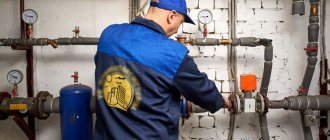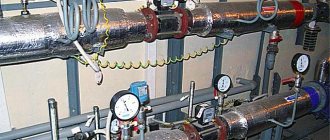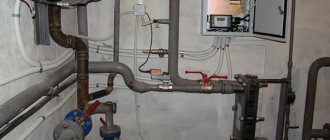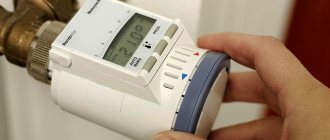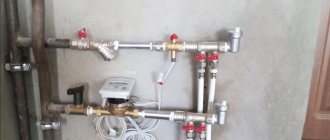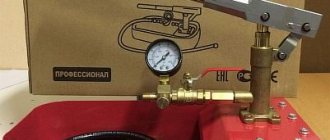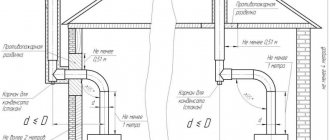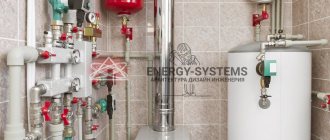Expert author of the article
Alexander Georgievich Kondratiev
An electrical engineer by training, he worked as an electronics engineer, chief engineer at a food company, and general director of a construction organization.
Utility tariffs are constantly rising, and residents are looking for legal ways to save. The main payment in winter is the payment for heating the apartment. A common house heat meter in an apartment building can significantly reduce payments. Residents of high-rise buildings should figure out whether there is any benefit from a heat meter, how to organize the installation, whether it is necessary to install it, and how the heating fee will be calculated.
Why do you need a common house appliance?
Apartment owners are already accustomed to local meters, which are installed in the apartment or on the landing. To account for thermal energy, common house thermal energy metering devices are installed. They are installed on one entrance or the whole house.
Based on the law, heat energy metering must be carried out in every apartment building. The main task that should be solved with the help of meters, as conceived by legislators, is a prudent and economical attitude to the consumption of thermal energy.
But the installation of devices is associated with significant material costs, which fall on the shoulders of the residents of the house.
These devices themselves do not save heat, they only count consumption. Savings can be achieved if residents follow certain rules. They are necessary to reduce non-standard losses, and depend on the condition of the windows, their glazing, the presence or absence of doors in the entrance, and their insulation.
Entrances, attics and basements are common property that is heated. And all residents have to pay for their heating. If you keep the window open all the time, it will be difficult to save on heating costs.
Moreover, all residents of the entrance will have to pay for this. Since the cost will be recorded by a common building metering device and distributed to all residents. Installing a heat meter will be beneficial provided:
- Residents of an apartment building take a responsible approach to the thermal insulation of their building. If the building is equipped with a heat meter, then payment for heating will be charged for the energy consumed, and not at regional tariffs, which take into account standard losses. And in each region they are different and often exceed the real ones by several times;
- Meters encourage residents to be rational about heat conservation not only in the apartment, but also in the entrance. All doors must be kept closed at all times during the cold season. The windows have been repaired and glazed. When people understand that an open door or broken window will affect the amount of payment, this will be the best incentive to keep the entrance in order;
- Installation of a heat meter will encourage management companies to take their responsibilities responsibly. Residents will require the property to be maintained in proper order. After all, they pay for these services out of their own pockets.
Meter with ITP - thermal independence
Yes, a common house meter reduces waste on heat energy by up to 30% and fully pays for itself in 3 years, but it would be nice not only to monitor heat consumption, but also to manage it. By installing not only a metering device, but also an individual heating point, consumers can regulate the temperature of the coolant supplied to the system. Also, thanks to the ITP, it becomes possible to regulate the pressure in the system - this is a significant plus, given the possible frequency of its drops, which entails pipe breaks.
It is no secret that in apartment buildings, heat can be distributed unevenly between apartments. The reason for this phenomenon lies in the imbalance of the heating system. Agree, the situation is familiar: in apartments on the upper floors the heat is unbearable, while on the lower floors the radiators are slightly warmer than icy (or vice versa). ITP easily eliminates this problem too.
Equipping it is quite simple: a heat exchanger, a couple of pumps, wiring and the heat meter itself.
Legislative basis
Installation of devices is mandatory for all apartment buildings. What is regulated by Federal Law No. 261-FZ of November 23, 2009 and amendments that entered into force on August 10, 2018, “On energy saving and increasing energy efficiency, and on introducing amendments to certain legislative acts of the Russian Federation.”
However, the implementation of this law is associated with some features:
- The purchase, installation and commissioning works are paid for by the residents of the house. And after commissioning, the equipment becomes household property. Moreover, the costs of acquisition, design and commissioning amount to quite large amounts;
- Regular maintenance is required to keep equipment in good working order. It also falls on the shoulders of the residents. And when concluding a service agreement with the management company, residents will be billed for maintenance;
- The law does not regulate equipment failure. If the meter readings are inflated, residents will not be able to prove anything. They will have to pay for heat based on the meter readings;
- Residents of non-privatized apartments may not pay the cost of a common building meter for heat. By law, all costs must be borne by the building owner. This may be a municipal government or an organization in whose department the property is located.
Results
The Energy Saving Law obliges residents of apartment buildings to install common heat energy meters at their own expense, with the exception of houses that do not meet the technical capabilities.
Both the management company and the RSO take part in the ODPU installation procedure, with the first organizing, and the second being responsible for installing the device. In case of failure to fulfill their obligations, companies will be fined, and residents will receive a receipt for heating payment with an increasing coefficient. Time will tell how expedient the forced installation of collective meters is, but the effect of using ODPU is undeniable: heating costs are reduced by up to 30%.
At what objects is a meter needed, and where is it not necessary to install it?
The law determines that all owners of buildings, houses, and apartments are required to equip their buildings with communal heating meters by 2011. What is regulated by Article 13, Section 4 of Federal Law No. 261.
And section 3 obliges all government organizations to equip them with thermal appliances. However, Section 1 of Article 13 indicates facilities where the installation of meters is not required.
These are emergency or dilapidated buildings, structures that are subject to demolition. There is no need to install heat meters on houses with a maximum consumption of thermal energy not exceeding two tenths of a gigacalorie per hour.
Principle of operation
A common house heat meter performs several functions simultaneously. It allows you to see the operating time of electrical appliances indicated on a specific metering unit. The heat meter shows the temperature of the coolant and records the exact amount of thermal energy consumed. The circuit of a general heat energy meter includes the elements:
- Thermal converters are sensors that measure temperature.
- A computer that calculates the amount of heat spent.
- A flow meter that measures the mass and volume flow of a substance.
- Power unit.
The heat meter is designed to record the received heat supplied by the coolant. The equipment determines the amount of energy used by the device per hour, taking into account the temperature of the fluid entering/leaving the system. In this way, the temperature difference over a certain period of time is determined. For this purpose, a special computer is built into the electric meter.
IMPORTANT! Calculation of thermal energy is carried out with an error of 3-6%.
Data is supplied using built-in temperature and flow sensors. The first temperature sensor is installed in the supply pipe of the engineering system, and the second - in the outgoing pipe. The computer analyzes all the data received, after which the exact figure for thermal energy consumption is displayed on the device screen.
Is it possible to refuse to install a common house heat meter?
According to the law, all apartment buildings must be equipped with communal heat meters. Exceptions apply to houses specified in Section 1 of Article 13. As well as to buildings whose communications require major repairs or do not allow the installation of meters for other reasons.
In all other cases, the law requires the installation and installation of equipment. And newly commissioned housing will not be put into operation without a heat meter installed.
Automatically transmit readings
Smart meters are meters equipped with special radio modules that automatically transmit readings via a long-range wireless network. Individual or communal metering devices transmit their data to an information system that can receive information from hundreds of thousands of sensors within a radius of several tens of kilometers.
All data received from the control center is automatically sent to the utility service provider; the consumer can track the readings, but they are transmitted for calculations without human intervention from all metering devices in the house on the set day and time.
How to correctly take readings from water meters. Instructions
30360
How much does it cost and who pays
The issue of the cost of equipment and related services becomes paramount. Since, according to the law, residents of an apartment building must pay for equipment, design, commissioning and commissioning.
As a result, the common building meter becomes the collective property of the residents. The cost of heat meters depends on the manufacturer and type of equipment:
- Inexpensive devices with a short service life of 2 to 4 years, costing from 6 to 10 thousand rubles. These are meters that use a rotor as an actuator;
- More reliable electronic devices cost from 15 to 100 thousand rubles. The service life of such devices is 10-15 years.
But this is not the main price you need to pay for installation.
Total costs consist of the following expense items:
- Design work. This includes the development and approval of the project. The estimated cost is 50 thousand rubles;
- Heat meter. Usually they choose reliable devices in the middle price category of about 60 thousand rubles. With a service life of at least 10 years;
- Additional equipment, flow meters and sensors. The price of the devices is 40 thousand rubles;
- Installation of equipment and auxiliary materials. Repair of worn-out networks is taken into account. The cost of the work is 90 thousand rubles;
- Equipment setup and commissioning costs 10 thousand rubles.
The cost of installation and commissioning of a thermal energy meter ranges from 180 to 300 thousand rubles. This is the estimated price for the work. It depends on the organization that will perform installation, commissioning and commissioning.
The management company does not perform this work; they require special permission.
What types of devices are there?
Each heat meter is a set of devices that includes sensors, units responsible for recording consumed heat, and all kinds of converters that work with pressure, flow and resistance indicators of the coolant.
The meter's configuration is determined by the manufacturer and differs depending on the model. The most common are ultrasonic and mechanical devices, while vortex and electromagnetic devices are practically unpopular due to their complexity and high cost.
There are also calculators and thermal energy distributors that do not need to be built into the thermal circuit; such devices can be used in absolutely any circuit.
| Type | Peculiarities |
| Mechanical | The simplest type of design, therefore its price is quite low and is at the level of 9-10 thousand rubles. This is a device with wired temperature sensors, a water meter and an electronic unit. The working element is a part that rotates as the coolant passes through the device, and it is the number of revolutions that determines the volume passed through the device. Two thermometers are placed on the supply and return pipes, and this can be done both vertically and horizontally |
| Ultrasonic | The amount of media consumed in this type of device determines the ultrasonic signal thanks to the emitter and receiver, while they are mounted on a horizontal pipe, but with a certain distance. The emitter signal travels through the water and reaches the receiver, and the time is calculated based on the speed of water movement in the circuit. Ultrasonic samples can regulate the flow in some variations, but this is the domain of advanced models |
| Calculators and distributors | These devices measure relative heat costs and consist of thermal adapters and two sensors. Once every three minutes, sensors measure the temperature, being installed on the battery and in the room, while displaying the difference in values. The information that is received is displayed on the display. These devices are programmed in advance for coefficients and radiator power, and as a result, the heat consumption indicator will be displayed in kilowatt-hours |
Is it possible not to pay for installing a meter?
In some cases, a heat meter can be installed free of charge. This option is possible when residents do not have the funds to pay for a heat meter.
The management company or homeowners association enters into an energy service contract. According to it, the energy service company purchases and installs equipment at its own expense.
After installing the structure and putting it into operation, the heat meter is leased. Payment for equipment is made at the rate of 80% of the savings achieved. The energy service company takes it, and 20% remains the property of the residents.
For example, a house paid 400 thousand rubles for heat before installing a meter. After installation, the payment decreased to 350 thousand. Saving 50 thousand rubles. The energy supply company takes 40 thousand rubles.
According to the leasing agreement, she receives 300 thousand. Thus, after (300/40=7.5) 7.5 months, the equipment will be transferred to the residents of the house. After the heat meter is handed over to the residents, all savings are distributed among the apartment owners.
Read what the temperature in the apartment should be during the heating season and how to request a recalculation for cold radiators.
Calculation of tariffs for services in public places
Public places include the following:
- Basement.
- Entrance.
- Flights and landings.
- All kinds of storage rooms.
If we are talking about communal apartments, which are still found, then areas such as the bathroom, kitchen and corridor are added to this list. In other words, this is absolutely any place where all owners living nearby have access.
Such objects, as you know, are lit and heated, and payments are distributed to all owners. Calculations for such “public” services are carried out according to a special formula with such indicators as:
- C (general) – payment for the service provided in public places.
- P – parameters of common house appliances.
- T – tariff for services relevant for a certain region.
- C (ind) – payment for each resident according to individual meters.
The calculation formula looks like this: the volume of the resource provided is divided by the volume of consumed, recorded in the installed meters.
The result calculated during the calculation process in kilowatts or cubic meters is translated into a monetary amount that must be paid by all residents. It is divided among all owners of residential premises.
Procedure for residents and management companies when installing meters
Home owners should start with a general meeting. It is usually carried out by the management company. This is where the decision to install equipment is made.
Select the type of device and approve the preliminary budget. After the meeting, a contractor is selected and an agreement is concluded with it to perform the work.
Together with the management organization, residents monitor the progress of work. If necessary, adjustments are made. Participate in testing. They are present when the facility is handed over to the heat supply company, which seals the devices and draws up a commissioning report.
Only after the heat supply company has accepted the work, the meter readings are the basis for payment for heat.
At the same time, you do not need to rely on the management company. She can organize a general meeting of residents, explain the need to install a meter, and draw up the relevant documents. And in some cases, help select a contractor.
But choosing a contractor, purchasing equipment, drawing up contracts for installation and commissioning work fall on the shoulders of the residents of an apartment building.
Calculation of heat energy consumption using a collective meter
Compared to the standards, the installation of ODPU provides more accurate accounting of thermal energy consumption. The calculation is based solely on meter readings, taking into account the difference between them at the end and beginning of the calculated period. This value is required to calculate the amount payable for heating.
The formula for calculating the cost of heating is as follows:
P = Qtot x S / Stot x T.
In other words, the volume of heat according to the meter (Qtotal) is multiplied by the area of the house (S), divided by the area of the apartment (Stotal) and multiplied by the tariff (T). (RUB/Gcal), approved by local governments for each region separately.
Find out more about how heating is calculated for an apartment.
Responsibility for lack of meters
The absence of ODPU is considered a violation of the law, which threatens the management company and the HOA with fines, and residents with an increased coefficient. Currently, this value is 1.6 of the heat supply tariff. The increasing factor does not apply to houses where it is not technically possible to install meters.
A resource-saving organization may be fined on several grounds:
- non-compliance with the requirements for submitting proposals for equipping apartment buildings with heat metering devices. The fine will be from 20 to 30 thousand rubles for officials and from 100 to 150 thousand for legal entities (clause 6 of article 9.16);
- Unreasonable refusal or evasion from concluding an agreement for the installation of ODPU and/or its execution is subject to a fine of 20-30 thousand rubles for officials and from 50 to 100 thousand for legal entities (Clause 12 of Article 9.16 of the Code of Administrative Offenses of the Russian Federation).
The management company can be fined for failure to comply with notification measures, because its function is to encourage residents to install a meter, justifying the need for this measure. The fine will range from 5 to 10 thousand rubles for officials and from 20 to 30 thousand for legal entities (clauses 4-5 of Article 9.16 of the Code of Administrative Offenses of the Russian Federation).
Read more about how the responsibility of the management company manifests itself.
What types of communal meters are there?
The industry produces several types of metering devices. They differ in performance and operating principles.
Mechanical
A tachometer or mechanical counter records the passage of coolant using an impeller or rotor. The rotor revolutions are counted by a computing unit.
The structure includes heat sensors and a computing unit. This is a device designed for a small home.
The mechanism is demanding on the quality of the coolant. In networks with low-quality coolant, dirty and hard water, tachometer meters are not installed. During installation, it is necessary to install a magnetic-mechanical filter.
Ultrasonic
The measuring principle is based on the passage of ultrasound through a stream of water. The devices are sensitive to mechanical inclusions and air bubbles in the coolant.
If they are present in water, it is impossible to obtain reliable data. This is an expensive and reliable device. Can work for a long time with high-quality coolant.
Electromagnetic
Accounting is carried out on the basis of counting the passage of liquid processed by a magnetic field in an electromagnetic unit. Where the liquid is magnetized, and in special modules the coolant is calculated.
Installation is carried out by trained specialists. Requires constant maintenance. With proper maintenance it works for a long time without repair.
The advantages include high accuracy of readings. If metal impurities are present in the coolant, the device readings will be unstable.
Vortex
The design uses the principle of vortex counting. An obstacle is placed in the path of the coolant, which creates turbulence. Their number depends on the flow.
The structure can be installed on both horizontal and vertical sections of the system. Pressure changes affect readings.
For normal operation of the heat meter, a filter for mechanical cleaning of the coolant is installed. They are not sensitive to small metal inclusions.
Additional technical information
- If the heat consumption is insignificant, and the heating system has a high pressure, the installation of inexpensive mechanical meters is allowed. When, on the contrary, the flow rate is significant and the pressure is small, the consumption of thermal energy will be recorded more accurately by an electromagnetic or ultrasonic device. By the way, most of the installations include house-wide ultrasonic devices.
- In addition to heat, metering devices record the consumption of hot water; now modern device models count coolant with a temperature of less than 40 degrees as cold, which is reflected in the amount of payment for heat supply.
- A useful measure for an apartment building would be to conduct an energy audit to identify the causes of heat loss. Then measures should be taken to eliminate them. Of course, such work will be expensive.
- When it is decided to install a mechanical meter, in addition to installing coarse filters, it is necessary to use a magnetic-mechanical filter in steel pipes to retain scale and rust. It is capable of filtering out metal particles that are so small that they pass through the mesh.
Purchase and installation of a common house heat meter
Before the general meeting where a decision on the type of meter will be made, it is recommended to contact an organization that installs and maintains heat metering devices.
The contractor's engineers, on the instructions of the residents, will carry out the following work:
- Audit of the home heating system;
- Based on the audit data, they will recommend the type of device that will meet all the necessary requirements. It should be taken into account that many meters have blocks for remote data transfer. And the service life must be at least 10 years;
- They will develop design documentation, install and commission the meter;
- After the end of the warranty period, maintenance of heat meters will be carried out.
When applying, you should find out whether the company has permission to perform this type of work.
Types of heat meters: which one is better to choose
Before installing a heating meter for an apartment building, you should familiarize yourself in detail with its main characteristics and operating principle. Today there are several types of heat meters, among which are:
- Mechanical meters are currently considered the cheapest and simplest. The basic principle of operation of these devices is to convert the translational movements of the coolant into the movement of a special measuring system. Typically, turbine, screw and vane types of mechanical heat meters are distinguished. It should also be noted that such devices are strictly not recommended for use with hard water - this can lead to clogging of the device with scale and other sedimentary substances. In this case, the best option would be to use a special filter for water purification.
- Electromagnetic meters operate on the principle of the generation of electric current as a result of the passage of an electronic carrier through a magnetic field.
- Vortex heat metering devices operate on the principle of detecting and analyzing vortex that appears directly in the path of coolant movement. It should be noted that this type of meter reacts negatively to the presence of significant impurities in the coolant, as well as to sudden changes in temperature and air in the lines.
- Ultrasonic heat meters are currently among the most accurate and efficient. The operating principle of this type of metering device is based on the passage of a special sound signal through the coolant, as well as the indicator of the time during which the coolant arrives from the primary source to the ultrasonic signal receiver.
Calculation of payments for intra-apartment and communal heat energy consumption
All residents are concerned about the question of how heating fees in an apartment building are calculated. This is the most significant amount on the payment receipt. There are several options for paying for consumed heat. There are only three such options.
Option No. 1: The house has a common house meter, and the apartments have individual heat meters
This accounting system is used in new buildings. Apartment heating in houses is carried out with horizontal wiring. This made it possible to install one individual meter per apartment.
Residents make payments based on individual meter readings. However, in this case, the costs of heat spent on heating common property - entrances, attics, etc. - are not taken into account.
Read about how payment is calculated for an individual heat meter in an apartment building.
To pay for common areas, the following calculation formula is used. Readings from local devices are taken. They are summed up and subtracted from the readings of the common house meter. The difference is divided among all residents in proportion to the area of the apartment occupied by the owner.
Option No. 2: the house has a communal meter, the apartments do not have meters
Heating bills are calculated according to the following algorithm:
- The area of all heated premises is taken. This includes attics, basements and entryways. The meter readings, multiplied by the tariff, are divided by the total area. We get the cost of one square meter;
- The common house share is calculated for each apartment;
- The common house share is added to the area of the apartment;
- The total area is multiplied by the cost of heating one square meter.
This will be the heating charge for each apartment.
Option No. 3: There are no heat meters
This option shouldn't exist. However, not all houses have communal meters. And what a situation will last for several more years.
Payment is calculated based on the area of the apartment. The share of the common house heated area is added to this area.
The resulting value is multiplied by the tariff. In each region, local authorities approve their own tariff. They operate throughout the heating season or are distributed evenly throughout the year.
This allows you to reduce “winter” payments. At the end of the heating season, a recalculation is performed based on actual temperature changes.
Based on the recalculation results, residents receive compensation (the overpayment is counted toward future payments) or pay extra and receive a new bill for consumed heat.
Measures to save on heating
What actions can be taken to make real savings? First of all, install an individual heat meter plus thermostatic heads or throttles. In this case, the consumer will pay for the heat that he really needs to ensure comfortable living conditions. At the same time, the apartment owner becomes less dependent on the behavior of his neighbors. To implement such measures, you can install a heat meter at the point where heating is introduced into the apartment, which must be sealed by employees of the heat supply organization. Thermostats or chokes are installed on the connections to heating devices. Cheaper in cost are chokes. In some cases, you can entrust the adjustment even to ordinary valves. But it is quite difficult to regulate the temperature of the coolant in the radiator using them. Experts do not recommend using screw valves for these purposes, since the rubber gaskets in them can block the gap and leave the room without heat.
Mechanical or digital thermostats are considered ideal devices. Their head should be installed so that they do not fall into the flow of hot air rising upward from the heating device. After calibration, the thermostatic head is able to maintain the required degree of supply necessary to maintain the desired temperature in the room.
Many owners of apartments with rack-type heating systems are interested in how to solve the problem taking into account the consumed thermal energy, because installing metering devices on each radiator will cost a considerable amount of money. In addition to significant initial costs, the consumer will have to periodically pay for their maintenance, verification and repairs in the event of a breakdown. Perhaps a special heat dispenser shown in the photo will help solve this problem. It is an electronic thermometer that constantly takes and records the temperature of the surface of the battery and the air in the room. This device is inexpensive and can be installed independently by attaching directly to the surface of the radiator. Based on the thermal power of each battery, the temperature of the radiator and air throughout the month and the total consumption of thermal energy by all heating devices, the heat consumption in a separate apartment is calculated. As a result, the property owner has an incentive to save on heating costs, since he only has to pay his own expenses.
Promote transparency of payments and reduce theft
The intelligent system makes it possible to make payments for resources transparent: both in the relationship between the CG contractor and the consumer, and between the management company and the RSO. Each party has the opportunity to monitor meter readings and see real consumption volumes. The problem that many MAs face with direct contracts will disappear - the difficulty of obtaining testimony from the RSO. Information will be available online to all parties to the relationship.
“Smart” metering devices help reduce the level of resource theft: it is more difficult to interfere with the operation of such a metering device, and it will not be possible to hide a sharp decrease in consumption in the apartment, because the data is sent directly to the utility provider. With an increase in the volume of CDs on SOI, the management organization can easily check and compare the data for each apartment and discover where they have sharply decreased.
How to distinguish unaccounted resource consumption from non-contractual consumption
95321
Benefits of using meters
House-wide flow meters can significantly save on heating costs. The price for heat, calculated according to actual indicators, is on average 30% lower than according to standards.
The high cost of a common house heat metering device is reimbursed within three years from the date of installation, since such a device allows reducing heat payments by almost a third
In addition, when paying at established tariffs, the beginning/end of the heating period is not taken into account: regardless of the specific date, the accrual is made for the whole month.
But a building-wide meter does not solve all problems with paying for heating, since in this case all apartment owners have to pay according to average data, regardless of the amount of heat consumed.
Although the cost of an individual heat control device is quite significant, it pays for itself quite quickly, especially if measures are taken to save heat energy
In this case, residents will be helped out by an individual heat energy meter, which also allows you to regulate the heat output of radiators.
Must be in all areas of the house and not fail
Experience in installing such systems has shown that in the first six months, new equipment may malfunction and make errors when transmitting readings. In this case, the utility service provider may receive claims from consumers and make many recalculations.
As already mentioned, the system will only work if all the metering devices in the house are “smart”: then they will ensure simultaneous readings are taken and transmitted to the utility service provider. And if at least one owner refuses to change the old control system to a “smart” one, then the required effect from the operation of the automated system will not be achieved.
Even if the OSS decides to force a dissenting resident to replace or upgrade the meter installed in the apartment, it will not be easy: the owner has the legal right not to allow anyone into the premises he owns.
What the RA needs to know about the installation of common house metering devices
179224
Before installing the flow meter you need to know
All costs for purchasing, installing, and maintaining the device are borne by residents. Owners of non-privatized apartments are reimbursed for installation costs by the local municipality.
When choosing a company to install a heating meter, you need to find out whether it has permits, approvals and certificates, as well as a certificate of state registration
Choosing an organization that will install the device requires special attention. It is advisable that the same company also handles maintenance of the meter, including timely cleaning of filters, carrying out routine repairs, and regularly checking the serviceability of the device.
External negative factors
It is also important to take into account that the correct operation of flow meters is influenced by many external factors.
Among them are reasons such as:
- Formation of mineral deposits in pipes, which reduces their internal diameter. This causes the flow to increase. Since measuring instruments are designed for a certain size of elements, reducing this indicator will lead to incorrect calculations, and the result obtained will exceed the actual value.
- Presence of impurities in water. Mechanical impurities and air bubbles cause a significant error in readings, reaching 10%. To purify liquids, it is recommended to additionally equip devices with filters that trap foreign particles.
- Precipitation on flow meter parts. When using mechanical structures, such a process reduces readings, while in other types of instruments it causes a significant (sometimes multiple) excess of actual values.
- Unfavorable microclimate of the room where the measuring device is installed. Dampness and temperature changes especially affect devices with electronic mechanisms.
- Lack of grounding and poor electrical circuits, which can result in electrical potential in the pipeline.
- Uneven pressure in the system negatively affects the accuracy of the measurements. The same can be said about carelessly installed meter, which can also distort the data.
- Coolant temperature. Hot liquid, the temperature of which exceeds the permissible limits, can damage the meter elements.
To avoid incorrect readings and prolong the life of the device, it is important to regularly carry out qualified maintenance and inspection of the device.
Ways to save money in general
There are several proven ways to reduce heating payments generated using public meters.
Insulating the facade of a house using mineral wool, polystyrene foam or other materials will reduce heat transfer to the environment, and therefore reduce heat consumption
The following joint activities will help reduce indicators:
- high-quality insulation of the building;
- full glazing of the entrance with the replacement of conventional frames with more durable and heat-insulating metal-plastic products.
Although such measures will require a one-time investment from residents, they are beneficial in the long term.
